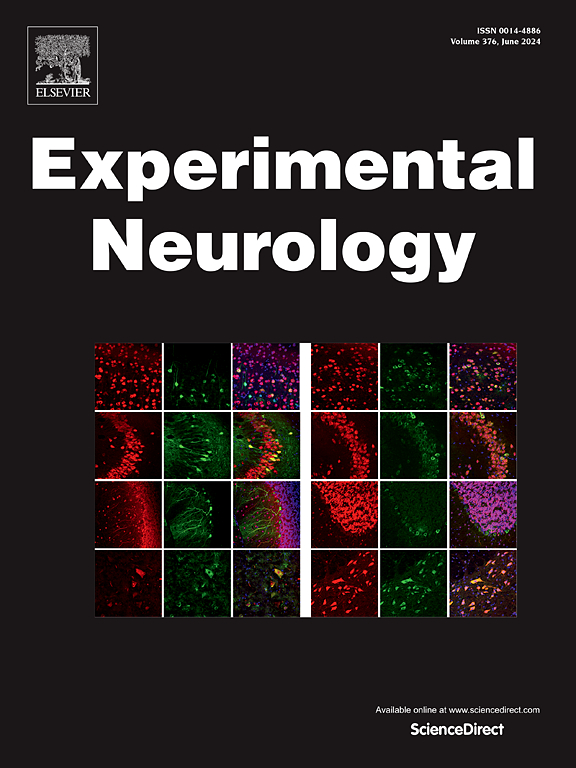Daily acute intermittent hypoxia elicits age & sex-dependent changes in molecules regulating phrenic motor plasticity
IF 4.6
2区 医学
Q1 NEUROSCIENCES
引用次数: 0
Abstract
Acute intermittent hypoxia (AIH) elicits a form of respiratory motor plasticity known as phrenic long-term facilitation (pLTF). Exposure to repetitive daily AIH (dAIH) enhances pLTF, a form of metaplasticity. Little is known concerning cellular mechanisms giving rise to dAIH-induced metaplasticity and the age-dependent sexual dimorphism of AIH associated pro-plasticity mRNA expression. To test if age, sex, and dAIH effects are associated with differential expression of molecules that regulate the Q- and S-pathways and their cross-talk interactions to phrenic motor facilitation, we analyzed key regulatory molecules in ventral spinal (C3-C5) homogenates from young (3-month) and middle-aged (12-month) male and female Sprague-Dawley rats. Since CNS estrogen levels impact molecules known to regulate the Q- and S-pathways, mRNA was correlated with serum estradiol. Rats (n = 8/group) were exposed to sham (21 % O2) or dAIH (15, 1 min episodes of 10.5 % inspired O2) per day for 14 days and sacrificed 24 h later. mRNAs for pLTF regulating molecules were assessed via RT-PCR, including: brain-derived neurotrophic factor (Bdnf); serotonin 2 A (Htr2a), 2B (Htr2b), and 7 (Htr7) receptors; adenosine 2a (Adora2a) receptors; exchange protein activated by cAMP (Epac1); p38 MAP kinase [Mapk14 (α) & Mapk11 (β)]; PKA regulatory (Prkar1a) and; catalytic subunits (Prkaa1); fractalkine (Cx3cl1), which underlies motor neuron/microglia communication; phosphodiesterase type 4b (Pde4b); NAPDH– gp91 (Cybb) and p47 (ncf1); and the PKC isoform, PKCδ (Prkcd). Here we report that age, sex, dAIH preconditioning, and estradiol influence molecules that initiate and/or regulate the Q- and S-pathways to phrenic motor facilitation.
每日急性间歇性缺氧引起调节膈肌运动可塑性的分子的年龄和性别依赖变化
急性间歇性缺氧(AIH)会引起一种称为膈肌长期促进(pLTF)的呼吸运动可塑性。暴露于每天重复的 AIH(dAIH)会增强 pLTF,这是一种变态反应。人们对dAIH诱导的变态反应的细胞机制以及与AIH相关的促变态反应mRNA表达的年龄依赖性双态性知之甚少。为了测试年龄、性别和 dAIH 影响是否与调控 Q 和 S 通路的分子的不同表达及其与膈肌运动促进的交叉相互作用有关,我们分析了幼年(3 个月)和中年(12 个月)雌雄 Sprague-Dawley 大鼠腹侧脊髓(C3-C5)匀浆中的关键调控分子。由于中枢神经系统雌激素水平会影响已知的 Q 和 S 通路调控分子,因此 mRNA 与血清雌二醇相关。大鼠(n = 8只/组)每天暴露于假氧(21% O2)或dAIH(15次,每次1分钟,10.5%启发氧),持续14天,24小时后处死。通过 RT-PCR 对 pLTF 调控分子的 mRNA 进行了评估,包括脑源性神经营养因子 (Bdnf);5-羟色胺 2 A (Htr2a)、2B (Htr2b) 和 7 (Htr7) 受体;腺苷 2a (Adora2a) 受体;cAMP 激活的交换蛋白 (Epac1);p38 MAP 激酶 [Mapk14 (α) & Mapk11 (β)];PKA调节亚基(Prkar1a)和催化亚基(Prkaa1);支撑运动神经元/小胶质细胞通讯的分叉蛋白(Cx3cl1);4b型磷酸二酯酶(Pde4b);NAPDH- gp91(Cybb)和p47(ncf1);以及PKC同工酶PKCδ(Prkcd)。在此,我们报告了年龄、性别、dAIH 预处理和雌二醇对启动和/或调节膈肌运动促进的 Q 和 S 通路的分子的影响。
本文章由计算机程序翻译,如有差异,请以英文原文为准。
求助全文
约1分钟内获得全文
求助全文
来源期刊

Experimental Neurology
医学-神经科学
CiteScore
10.10
自引率
3.80%
发文量
258
审稿时长
42 days
期刊介绍:
Experimental Neurology, a Journal of Neuroscience Research, publishes original research in neuroscience with a particular emphasis on novel findings in neural development, regeneration, plasticity and transplantation. The journal has focused on research concerning basic mechanisms underlying neurological disorders.
 求助内容:
求助内容: 应助结果提醒方式:
应助结果提醒方式:


